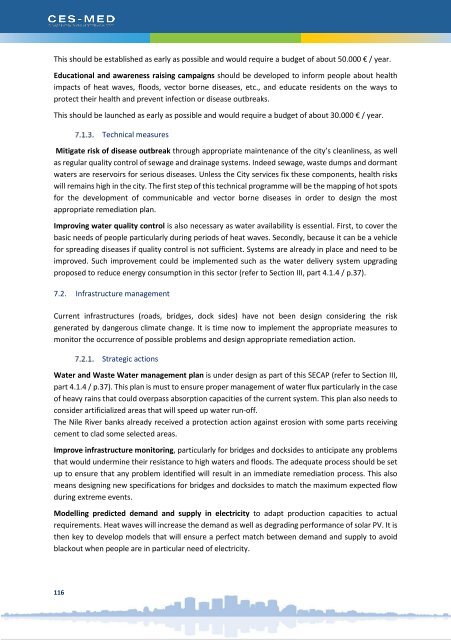130218_Luxor-Egypt SECAP Final
You also want an ePaper? Increase the reach of your titles
YUMPU automatically turns print PDFs into web optimized ePapers that Google loves.
3.5<br />
3<br />
R7<br />
2.5<br />
Probability<br />
2<br />
1.5<br />
1<br />
R4<br />
R10<br />
R6,R8<br />
R3<br />
R1, R2, R5,<br />
R9<br />
0.5<br />
0<br />
0 0.5 1 1.5 2 2.5 3<br />
Impact<br />
Figure 24: Risk assessment figure in case of climate data availability - <strong>Luxor</strong><br />
6. National Climate Change Adaptation and Mitigation Measures<br />
There is a noteworthy legal framework, but nevertheless, many policy plans are in implementation and<br />
many government agencies are responsible for integrating CC into the national policy agenda were<br />
executed. However, the Governorate of <strong>Luxor</strong> should develop their local policy and agenda for CCAMM.<br />
The Climate Change Mitigation and Adaptation Strategies fall under the mandate of the MoEnv and its<br />
executive arm EEAA. A climate change unit (CCU) was established in the EEAA in 1992, which has since<br />
been upgraded to the Central Department for Climate Change (CDCC).<br />
6.1. Climate Change Action Plan - CCAP<br />
The Climate Change Action Plan (CCAP) was developed by the MoEnv through the Second National<br />
Communication (SNC) to UNFCCC, which was established in 2000. An inventory of GHG emissions,<br />
including policies has been created to mitigate and evaluate their economic impacts after reduction.<br />
Such policy was not implemented or released until 2015.<br />
Results of the inventory of GHG emission yield an increase of the total emissions at an average of 5.1%<br />
yearly. The GHG emissions were highly influenced by four sectors that contribute significantly to total<br />
emissions. These are: a) energy, which accounted for 61% of the total in 2000, 27%, of which was<br />
transportation-related; b) agriculture by 16%; c) industrial processes by 14%; and d) waste by 9%.<br />
Despite, the reduction of GHG emissions reported above there are barriers to GHG mitigation.<br />
Such barriers can be summarised as follows:<br />
110<br />
• Institutional capacity constraints,<br />
• Lack of information about GHG reduction opportunities and technology, and<br />
• Limited access to investment capital needed to execute mitigation technologies and procedures.<br />
Nonetheless, an estimate of nearly 8.3mt CO 2-e reduction due to the existing mitigation efforts, which<br />
focused on three areas: a) Fuel substitution; b) Renewable energy; and c) Energy efficiency 59 .<br />
In addition, a Climate Change Risk Management Programme (CCRMP) was established in 2008 as a

















